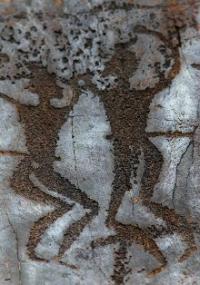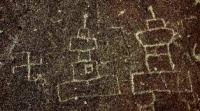Вы здесь
History study of cave paintings of Central Asia.


Petroglyph tours of Central Asia.
“Who knows that the first law of history is to be afraid of any lie, and then not be afraid of any truth?”
Cicero.
Petroglyphs of Central Asia.
The history of the study of rock paintings in Central Asia is not as vivid as it was, for example, in the history of the study of petroglyphs of Siberia (Okladnikov, Martynov, pp. 9-21; Devlet, 1980, pp. 5-15). At the end of the XIX century. Petroglyphs of Central Asia attracted the attention of major Russian scientists.
Among them, it should be noted N.A. Nasledova, N.S. Lykoshina, N.Y. Veselovsky, V.V. Barthold. Some discoveries of cave paintings are a significant contribution to the history of the science of petroglyphs. In 1902, N.G. Khludov Saimaly-Tasha petroglyphs, preliminary work with which A.I. Bernshtam (1952).
In 1912, the topographer Fedorov discovered a rock painting of Zarautsay, published later by the artist A.Yu. Roginsky (1950). Zarautsay's cave paintings and paintings from the Shakhty Grotto, discovered by V.A. Ranov in Tajikistan at the end of the fifties, are, according to experts, the oldest in Central Asia and are supposedly dated in the early Mesolithic (Formozov, 1969, p. 74).
Cave paintings of the Kyzylkum interfluve became known relatively recently. In 1940, petroglyphs were discovered by S.P. Tolstov in the right-bank Khorezm in the northwestern foothills of the Sultan-Wizdag on the sandy hills of Chilpyk, Kara-tyube and Besh-tyube.
His findings S.P. Tolstov dated the Bronze Age (1948, p. 82). In the prewar years, the study of rock paintings in our country was just beginning and, of course, that the issue of dating such material was at that time even more difficult than now.
Experts consider the petroglyphs of Khorezm not very ancient (Formozov, 1969, p. 79). The discoveries of new petroglyphs in this area on the same sandstone uplifts make it possible to talk about their dating more definitely.
Among the images of the same style, figures of sabers of the eastern type of the sixteenth and eighteenth centuries were found on the mounds of Naratyube-3. (Oskin, 1981, p. 119). At the end of the fifties in the south of Kyzylkumov Kh.I. Tsukhamedov in the Karatau massif near the city of Navoi discovered petroglyphs in the tract Sarmichsai. Perhaps this is one of the most interesting collections of primitive art in Central Asia.
Studies have shown that the most ancient group of Sarmichsai petroglyphs can be dated III - V millennium BC. (Kabirov, 1974, p.16). If we take into account less significant finds of petroglyph collections in the same areas of Karatau in the south of Kyzylkum and one mention of a group of late cave paintings near the city of Zarafshan at the Sugral well in the interior of the desert, then this, perhaps, exhausts the information about the history of the study of Inner petroglyphs Kyzylkumov (Kabirov, 1972, p. 50).
However, it is not without interest that we dwell on the first report on rock paintings of Bukantau, which is directly related to the topic of our research. Caravan routes and trails were laid through the Inland Kyzylkum from the Aral Sea to the south from ancient times.
One of these paths passed through Bukantau. For many centuries, travelers took drinking water from the wells and springs of this mountain range. At the same time, they could not help but see a huge number of rock paintings.
In 1834, a message appeared about the petroglyphs of this area. Apparently, this record should be considered the first message about rock paintings of this area. She was left by a 9th-grade official, titular adviser, Italian by origin Petr Ivanovich (Peteri) Demezon (Demezon, p.5), who should be considered the discoverer of the Bukantau petroglyphs.
In this regard, the travel records of P. B. Demeson should be emphasized. The teacher of oriental languages of the military school of Orenburg P.I. Demezon in the winter of 1833 - 1834 accompanied a caravan in the Bukhara Khanate (ibid., p. 26), coming from the Orsk fortress.
“We set up camp,” wrote P.I., Demezon, “on the Bukan Plain. In the south-west, the Bukan mountains covered with snow rose. We crossed them the next day in a place called Bukkali (the tract and spring of Bohali in modern spelling. pre-revolutionary "Bokly" - A.O.) ...
They (Kazakhs - A.O.) drew my attention to the images of people, carts and horses carved on the rocks in many places "(ibid., p. 33 - 34 ) There is in the diary of P.I., Demezon and the mention of the wells of Kirbukan.
However, a record of them was made by the traveler only in connection with the problem of water. "20 versts to the east (from the Bohali spring - A.O.) are the Bukan-Kuduk wells (the modern spelling" Kirbukan "is A.O.).
They were bombarded by Khiva four years ago. I drove them on the way back .. . "(ibid.). Entries by P.I. Demon, for us important not only as the earliest report on Bukantau petroglyphs. For us, his perception of visual material is very significant.
or example, he writes that local residents drew his attention to the images on the rocks of "people, carts and horses." P.I. Demezon could not help but see hundreds of figures of camels, but not a word about them in the diary.
There are few horse figures and even fewer images of people on the rocks, and he left a note about them. However, in these areas there are no images of wagons, while P.I. Demon wrote in the diary. Locals who have long lost all sorts of traditional concepts associated with petroglyphs are still called solar signs in the form of a cross in a circle “wheels from a cart”.
The traveler left his impressions of the "wheels of the cart" in his diaries as "carts". It is very remarkable that P.I. According to the locals, Demezon also wrote down a version of the legend related to the version of the creators of cave paintings in this area (see p. 57, Appendix I).
Field records of P.I. Demezon lay in the archives for one hundred and fifty years and were published only in 1983.
Authority:
“Petroglyphs of the Central Kyzyl Kum as a historical source for the study of archaic cults”. Oskin Alexander Vasilievich. Moscow, 1985.
Photos by
Alexander Petrov.







